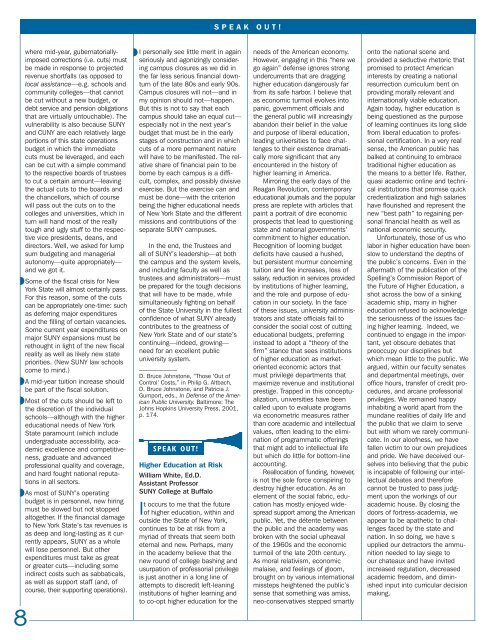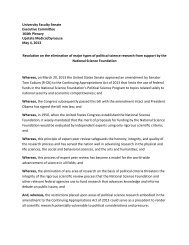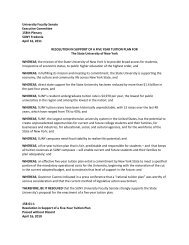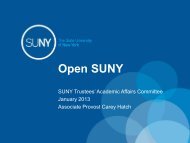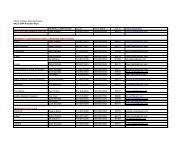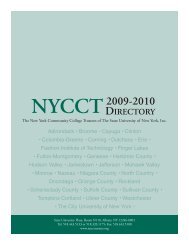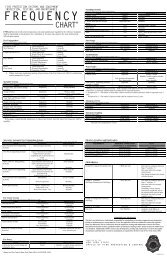Layout 1 copy - The State University of New York
Layout 1 copy - The State University of New York
Layout 1 copy - The State University of New York
You also want an ePaper? Increase the reach of your titles
YUMPU automatically turns print PDFs into web optimized ePapers that Google loves.
S P E A K O U T !<br />
where mid-year, gubernatoriallyimposed<br />
corrections (i.e. cuts) must<br />
be made in response to projected<br />
revenue shortfalls (as opposed to<br />
local assistance—e.g. schools and<br />
community colleges—that cannot<br />
be cut without a new budget, or<br />
debt service and pension obligations<br />
that are virtually untouchable). <strong>The</strong><br />
vulnerability is also because SUNY<br />
and CUNY are each relatively large<br />
portions <strong>of</strong> this state operations<br />
budget in which the immediate<br />
cuts must be leveraged, and each<br />
can be cut with a simple command<br />
to the respective boards <strong>of</strong> trustees<br />
to cut a certain amount—leaving<br />
the actual cuts to the boards and<br />
the chancellors, which <strong>of</strong> course<br />
will pass out the cuts on to the<br />
colleges and universities, which in<br />
turn will hand most <strong>of</strong> the really<br />
tough and ugly stuff to the respective<br />
vice presidents, deans, and<br />
directors. Well, we asked for lump<br />
sum budgeting and managerial<br />
autonomy—quite appropriately—<br />
and we got it.<br />
Some <strong>of</strong> the fiscal crisis for <strong>New</strong><br />
<strong>York</strong> <strong>State</strong> will almost certainly pass.<br />
For this reason, some <strong>of</strong> the cuts<br />
can be appropriately one-time: such<br />
as deferring major expenditures<br />
and the filling <strong>of</strong> certain vacancies.<br />
Some current year expenditures on<br />
major SUNY expansions must be<br />
rethought in light <strong>of</strong> the new fiscal<br />
reality as well as likely new state<br />
priorities. (<strong>New</strong> SUNY law schools<br />
come to mind.)<br />
A mid-year tuition increase should<br />
be part <strong>of</strong> the fiscal solution.<br />
Most <strong>of</strong> the cuts should be left to<br />
the discretion <strong>of</strong> the individual<br />
schools—although with the higher<br />
educational needs <strong>of</strong> <strong>New</strong> <strong>York</strong><br />
<strong>State</strong> paramount (which include<br />
undergraduate accessibility, academic<br />
excellence and competitiveness,<br />
graduate and advanced<br />
pr<strong>of</strong>essional quality and coverage,<br />
and hard fought national reputations<br />
in all sectors.<br />
As most <strong>of</strong> SUNY’s operating<br />
budget is in personnel, new hiring<br />
must be slowed but not stopped<br />
altogether. If the financial damage<br />
to <strong>New</strong> <strong>York</strong> <strong>State</strong>’s tax revenues is<br />
as deep and long-lasting as it currently<br />
appears, SUNY as a whole<br />
will lose personnel. But other<br />
expenditures must take as great<br />
or greater cuts—including some<br />
indirect costs such as sabbaticals,<br />
as well as support staff (and, <strong>of</strong><br />
course, their supporting operations).<br />
◗<br />
◗<br />
◗<br />
◗<br />
8<br />
◗<br />
I personally see little merit in again<br />
seriously and agonizingly considering<br />
campus closures as we did in<br />
the far less serious financial downturn<br />
<strong>of</strong> the late 80s and early 90s.<br />
Campus closures will not—and in<br />
my opinion should not—happen.<br />
But this is not to say that each<br />
campus should take an equal cut—<br />
especially not in the next year’s<br />
budget that must be in the early<br />
stages <strong>of</strong> construction and in which<br />
cuts <strong>of</strong> a more permanent nature<br />
will have to be manifested. <strong>The</strong> relative<br />
share <strong>of</strong> financial pain to be<br />
borne by each campus is a difficult,<br />
complex, and possibly divisive<br />
exercise. But the exercise can and<br />
must be done—with the criterion<br />
being the higher educational needs<br />
<strong>of</strong> <strong>New</strong> <strong>York</strong> <strong>State</strong> and the different<br />
missions and contributions <strong>of</strong> the<br />
separate SUNY campuses.<br />
In the end, the Trustees and<br />
all <strong>of</strong> SUNY’s leadership—at both<br />
the campus and the system levels,<br />
and including faculty as well as<br />
trustees and administrators—must<br />
be prepared for the tough decisions<br />
that will have to be made, while<br />
simultaneously fighting on behalf<br />
<strong>of</strong> the <strong>State</strong> <strong>University</strong> in the fullest<br />
confidence <strong>of</strong> what SUNY already<br />
contributes to the greatness <strong>of</strong><br />
<strong>New</strong> <strong>York</strong> <strong>State</strong> and <strong>of</strong> our state’s<br />
continuing—indeed, growing—<br />
need for an excellent public<br />
university system.<br />
___________<br />
D. Bruce Johnstone, “Those ‘Out <strong>of</strong><br />
Control’ Costs,” in Philip G. Altbach,<br />
D. Bruce Johnstone, and Patricia J.<br />
Gumport, eds., In Defense <strong>of</strong> the American<br />
Public <strong>University</strong>. Baltimore: <strong>The</strong><br />
Johns Hopkins <strong>University</strong> Press, 2001,<br />
p. 174.<br />
SPEAK OUT!<br />
Higher Education at Risk<br />
William White, Ed.D.<br />
Assistant Pr<strong>of</strong>essor<br />
SUNY College at Buffalo<br />
It occurs to me that the future<br />
<strong>of</strong> higher education, within and<br />
outside the <strong>State</strong> <strong>of</strong> <strong>New</strong> <strong>York</strong>,<br />
continues to be at risk from a<br />
myriad <strong>of</strong> threats that seem both<br />
eternal and new. Perhaps, many<br />
in the academy believe that the<br />
new round <strong>of</strong> college bashing and<br />
usurpation <strong>of</strong> pr<strong>of</strong>essorial privilege<br />
is just another in a long line <strong>of</strong><br />
attempts to discredit left-leaning<br />
institutions <strong>of</strong> higher learning and<br />
to co-opt higher education for the<br />
needs <strong>of</strong> the American economy.<br />
However, engaging in this “here we<br />
go again” defense ignores strong<br />
undercurrents that are dragging<br />
higher education dangerously far<br />
from its safe harbor. I believe that<br />
as economic turmoil evolves into<br />
panic, government <strong>of</strong>ficials and<br />
the general public will increasingly<br />
abandon their belief in the value<br />
and purpose <strong>of</strong> liberal education,<br />
leading universities to face challenges<br />
to their existence dramatically<br />
more significant that any<br />
encountered in the history <strong>of</strong><br />
higher learning in America.<br />
Mirroring the early days <strong>of</strong> the<br />
Reagan Revolution, contemporary<br />
educational journals and the popular<br />
press are replete with articles that<br />
paint a portrait <strong>of</strong> dire economic<br />
prospects that lead to questioning<br />
state and national governments’<br />
commitment to higher education.<br />
Recognition <strong>of</strong> looming budget<br />
deficits have caused a hushed,<br />
but persistent murmur concerning<br />
tuition and fee increases, loss <strong>of</strong><br />
salary, reduction in services provided<br />
by institutions <strong>of</strong> higher learning,<br />
and the role and purpose <strong>of</strong> education<br />
in our society. In the face<br />
<strong>of</strong> these issues, university administrators<br />
and state <strong>of</strong>ficials fail to<br />
consider the social cost <strong>of</strong> cutting<br />
educational budgets, preferring<br />
instead to adopt a “theory <strong>of</strong> the<br />
firm” stance that sees institutions<br />
<strong>of</strong> higher education as marketoriented<br />
economic actors that<br />
must privilege departments that<br />
maximize revenue and institutional<br />
prestige. Trapped in this conceptualization,<br />
universities have been<br />
called upon to evaluate programs<br />
via econometric measures rather<br />
than core academic and intellectual<br />
values, <strong>of</strong>ten leading to the elimination<br />
<strong>of</strong> programmatic <strong>of</strong>ferings<br />
that might add to intellectual life<br />
but which do little for bottom-line<br />
accounting.<br />
Reallocation <strong>of</strong> funding, however,<br />
is not the sole force conspiring to<br />
destroy higher education. As an<br />
element <strong>of</strong> the social fabric, education<br />
has mostly enjoyed widespread<br />
support among the American<br />
public. Yet, the détente between<br />
the public and the academy was<br />
broken with the social upheaval<br />
<strong>of</strong> the 1960s and the economic<br />
turmoil <strong>of</strong> the late 20th century.<br />
As moral relativism, economic<br />
malaise, and feelings <strong>of</strong> gloom,<br />
brought on by various international<br />
missteps heightened the public’s<br />
sense that something was amiss,<br />
neo-conservatives stepped smartly<br />
onto the national scene and<br />
provided a seductive rhetoric that<br />
promised to protect American<br />
interests by creating a national<br />
resurrection curriculum bent on<br />
providing morally relevant and<br />
internationally viable education.<br />
Again today, higher education is<br />
being questioned as the purpose<br />
<strong>of</strong> learning continues its long slide<br />
from liberal education to pr<strong>of</strong>essional<br />
certification. In a very real<br />
sense, the American public has<br />
balked at continuing to embrace<br />
traditional higher education as<br />
the means to a better life. Rather,<br />
quasi academic online and technical<br />
institutions that promise quick<br />
credentialization and high salaries<br />
have flourished and represent the<br />
new “best path” to regaining personal<br />
financial health as well as<br />
national economic security.<br />
Unfortunately, those <strong>of</strong> us who<br />
labor in higher education have been<br />
slow to understand the depths <strong>of</strong><br />
the public’s concerns. Even in the<br />
aftermath <strong>of</strong> the publication <strong>of</strong> the<br />
Spelling’s Commission Report <strong>of</strong><br />
the Future <strong>of</strong> Higher Education, a<br />
shot across the bow <strong>of</strong> a sinking<br />
academic ship, many in higher<br />
education refused to acknowledge<br />
the seriousness <strong>of</strong> the issues facing<br />
higher learning. Indeed, we<br />
continued to engage in the important,<br />
yet obscure debates that<br />
preoccupy our disciplines but<br />
which mean little to the public. We<br />
argued, within our faculty senates<br />
and departmental meetings, over<br />
<strong>of</strong>fice hours, transfer <strong>of</strong> credit procedures,<br />
and arcane pr<strong>of</strong>essorial<br />
privileges. We remained happy<br />
inhabiting a world apart from the<br />
mundane realities <strong>of</strong> daily life and<br />
the public that we claim to serve<br />
but with whom we rarely communicate.<br />
In our alo<strong>of</strong>ness, we have<br />
fallen victim to our own prejudices<br />
and pride. We have deceived ourselves<br />
into believing that the pubic<br />
is incapable <strong>of</strong> following our intellectual<br />
debates and therefore<br />
cannot be trusted to pass judgment<br />
upon the workings <strong>of</strong> our<br />
academic house. By closing the<br />
doors <strong>of</strong> fortress-academia, we<br />
appear to be apathetic to challenges<br />
faced by the state and<br />
nation. In so doing, we have s<br />
upplied our detractors the ammunition<br />
needed to lay siege to<br />
our chateaux and have invited<br />
increased regulation, decreased<br />
academic freedom, and diminished<br />
input into curricular decision<br />
making.


